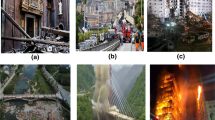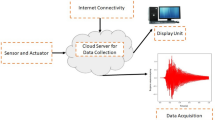Abstract
Structural Health Monitoring (SHM) has been considered to afford up-to-date information about the state of structures by assessing structural vibration responses and further physical phenomena and disorders. Determining the structure conditions is not an easy task which is associated with complex civil structures. The main objective of SHM is earlier damage detection, inspection cost reduction and lifetime estimation. The modern improvements of wireless sensor networks paid attention in the field of structural health monitoring. The deployment of sensors are expected to provide the rich information about civil structures in an effective manner. The main limitations of sensors (small memory size, small communication throughput, limited speed of the CPU) reduce the effectiveness of SHM. We propose concoction node fault discovery approach in order to provide reliable communication in the wireless environment specifically having lot of obstacles. The HRPD algorithm select the Line of sight (LOS) nodes based on extracted RSS features which is higher than non LOS. The selected intermediate LOS nodes transmit the collected sensing information to the base station with reduced energy consumption. The Statistical link parameter estimation supports to detect the optimal path through continuous analysis of link metrics such like link bandwidth, response time and queue size. The LOS fault tolerant approach determines the faulty LOS nodes, and direct the system towards survivability. The simulation results shows that our proposed approach minimize the energy depletion and enhances the sensor node’s life time. The application of the proposed work helps to monitor the structural health of buildings, bridges and towers with high quality monitoring mechanism.







Similar content being viewed by others
References
Chang, P. C., Flatau, A., & Liu, S. (2003). Health monitoring of civil infrastructure. Structural Health Monitoring,2, 257–267.
Lynch, J. P., & Loh, K. J. (2006). A summary review of wireless sensors and sensor networks for structural health monitoring. Shock and Vibration Digest,38, 91–130.
Lynch, J. P., Farrar, C. R., & Michaels, J. E. (2016). Structural health monitoring: technological advances to practical implementations [scanning the issue]. Proceedings of the IEEE,104, 1508–1512.
Nagayama, T., Sim, S.-H., Miyamori, Y., & Spencer, B., Jr. (2007). Issues in structural health monitoring employing smart sensors. Smart Structures and Systems,3, 299–320.
Kausar, A. Z., Reza, A. W., Saleh, M. U., & Ramiah, H. (2014). Energizing wireless sensor networks by energy harvesting systems: Scopes, challenges and approaches. Renewable and Sustainable Energy Reviews,38, 973–989.
Banerji, S. B. A., & Khazaeli, S. (2016). STR-991: Energy harvesting methods for structural health monitoring using wireless sensors: a review. In Proceedings of the Canadian Society for Civil Engineering Annual Conference, London, pp. 1–4.
Kottapalli, V. A., Kiremidjian, A. S., Lynch, J. P., Carryer, E., Kenny, T. W., Law, K. H., et al. (2003). Two-tiered wireless sensor network architecture for structural health monitoring. In Smart structures and materials 2003: Smart systems and nondestructive evaluation for civil infrastructures (pp. 8–19).
Rawat, P., Singh, K. D., Chaouchi, H., & Bonnin, J. M. (2014). Wireless sensor networks: a survey on recent developments and potential synergies. The Journal of Supercomputing,68, 1–48.
Baptista, F. G., Budoya, D. E., De Almeida, V. A., & Ulson, J. A. C. (2014). An experimental study on the effect of temperature on piezoelectric sensors for impedance-based structural health monitoring. Sensors,14, 1208–1227.
Hackmann, G., Guo, W., Yan, G., Sun, Z., Lu, C., & Dyke, S. (2013). Cyber-physical codesign of distributed structural health monitoring with wireless sensor networks. IEEE Transactions on Parallel and Distributed Systems,25, 63–72.
Sohn, H. (2007). Effects of environmental and operational variability on structural health monitoring. Philosophical Transactions of the Royal Society of London A: Mathematical, Physical and Engineering Sciences,365, 539–560.
Gao, Z., Cecati, C., & Ding, S. X. (2015). A survey of fault diagnosis and fault-tolerant techniques—Part I: Fault diagnosis with model-based and signal-based approaches. IEEE Transactions on Industrial Electronics,62, 3757–3767.
Menon, P. P., & Edwards, C. (2013). Robust fault estimation using relative information in linear multi-agent networks. IEEE Transactions on Automatic Control,59, 477–482.
Abdullah-Al-Wadud, M., & Hamid, M. A. (2014). A fault-tolerant structural health monitoring protocol using wireless sensor networks. Annals of Telecommunications,69, 219–228.
Swain, R. R., & Khilar, P. M. (2017). Composite fault diagnosis in wireless sensor networks using neural networks. Wireless Personal Communications,95, 2507–2548.
Sabet, M., & Naji, H. (2016). An energy efficient multi-level route-aware clustering algorithm for wireless sensor networks: A self-organized approach. Computers and Electrical Engineering,56, 399–417.
Naeem, M. K., Patwary, M., & Abdel-Maguid, M. (2017). Universal and dynamic clustering scheme for energy constrained cooperative wireless sensor networks. IEEE Access,5, 12318–12337.
Ye, Z., & Mohamadian, H. (2014). Adaptive clustering based dynamic routing of wireless sensor networks via generalized ant colony optimization. IERI Procedia,10, 2–10.
Fu, T. S., Ghosh, A., Johnson, E. A., & Krishnamachari, B. (2013). Energy-efficient deployment strategies in structural health monitoring using wireless sensor networks. Structural Control and Health Monitoring,20, 971–986.
Zhou, Z., Yang, Z., Wu, C., Sun, W., & Liu, Y. (2014). LiFi: Line-of-sight identification with WiFi. In IEEE INFOCOM 2014-IEEE Conference on Computer Communications (pp. 2688–2696).
Wu, C., Yang, Z., Zhou, Z., Qian, K., Liu, Y., & Liu, M. (2015). PhaseU: Real-time LOS identification with WiFi. In 2015 IEEE conference on computer communications (INFOCOM) (pp. 2038–2046).
Hassan, A., & Phillips, C. (2008). Particle swarm optimization-based DRWA for wavelength continuous WDM optical networks using a novel fitness function. Artificial Intelligence Review,29, 305.
Pereira, R. M., Ruiz, L. B., & Ghizoni, M. L. A. (2015). MannaSim: A NS-2 extension to simulate wireless sensor network. ICN,2015, 107.
Tan, N. D., & Hung, P. N. (2020). Analysis of energy consumption for IEEE 802.15. 4 MAC and SMAC protocols in wireless sensor network. International Journal of Advanced Research in Computer Engineering & Technology (IJARCET), 9. http://ijarcet.org/wp-content/uploads/IJARCET-VOL-9-ISSUE-4-133-138.pdf
Author information
Authors and Affiliations
Corresponding author
Additional information
Publisher's Note
Springer Nature remains neutral with regard to jurisdictional claims in published maps and institutional affiliations.
Rights and permissions
About this article
Cite this article
Surya, S., Ravi, R. Concoction Node Fault Discovery (CNFD) on Wireless Sensor Network Using the Neighborhood Density Estimation in SHM. Wireless Pers Commun 113, 2723–2746 (2020). https://doi.org/10.1007/s11277-020-07623-5
Published:
Issue Date:
DOI: https://doi.org/10.1007/s11277-020-07623-5




